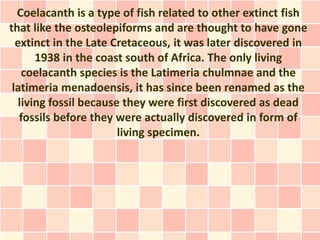
Coelocanth Rediscovery
- 1. Coelacanth is a type of fish related to other extinct fish that like the osteolepiforms and are thought to have gone extinct in the Late Cretaceous, it was later discovered in 1938 in the coast south of Africa. The only living coelacanth species is the Latimeria chulmnae and the latimeria menadoensis, it has since been renamed as the living fossil because they were first discovered as dead fossils before they were actually discovered in form of living specimen.
- 2. The unique thing with the coelacanth is that they have some features that aren't possessed by any other creature, for instance its body has Cosmoid scales that act like the armour protecting its exterior. It also has an intracranial joint that allows it to open its mouth extremely wide than the common fish and has a hollow backbone. This features gives the scientist and researchers the anxiety to research more on its body structure.
- 3. Another outstanding feature of the coelacanth fish is that it creates a link between the fish and the amphibians this is why it has such an importance to biotechnology. Hence scientists use its genes to measure the genetic differences of the coelacanth DNA. This is because coelacanth possibly survives in more adverse conditions and can encounter new diseases.
- 4. To biologists the coelacanth is an important species in the evolution of four- limped animals commonly known as the tetra pods. It is important because it tells the biologist about the genome and the evolution of modern day vertebrates, from the modern day stretching to over million years ago.
- 5. The coelacanth according to the scientist is important because they believe it may have given rise to the modern day vertebrates which are living on the land. This has lead to scientist researching more on the genes and blood structure of the coelacanth to determine and prove their assumptions.
- 6. The discovery of the coelacanth made it possible for the scientist to research more on their feeding habits and their modes of reproduction because they had never determined how the coelacanth reproduce and how their fertilisation occurs. This is because the scientists had only caught adults' coelacanths and never the young ones. Their reappearance made it possible for scientists to research on them and discover new theories about them relating to other vertebrates.
- 7. The importance of the coelacanth for evolutionary theory and palaeontology is shown to be paralleled in cultural, literary and artistic areas of human heritage. Through its evolution it will make scientists to compare its evolution and adaptive features to the current evolution status of the humans and maybe be able to predict the outcome in the future.
- 8. The reappearance of the Coelacanth has given the countries a source of income in the tourist sector because it has attracted many ecologists and scientists who travel to countries to learn and see for themselves the living fossil and make their own research and try to have answers for what they had doubts about.